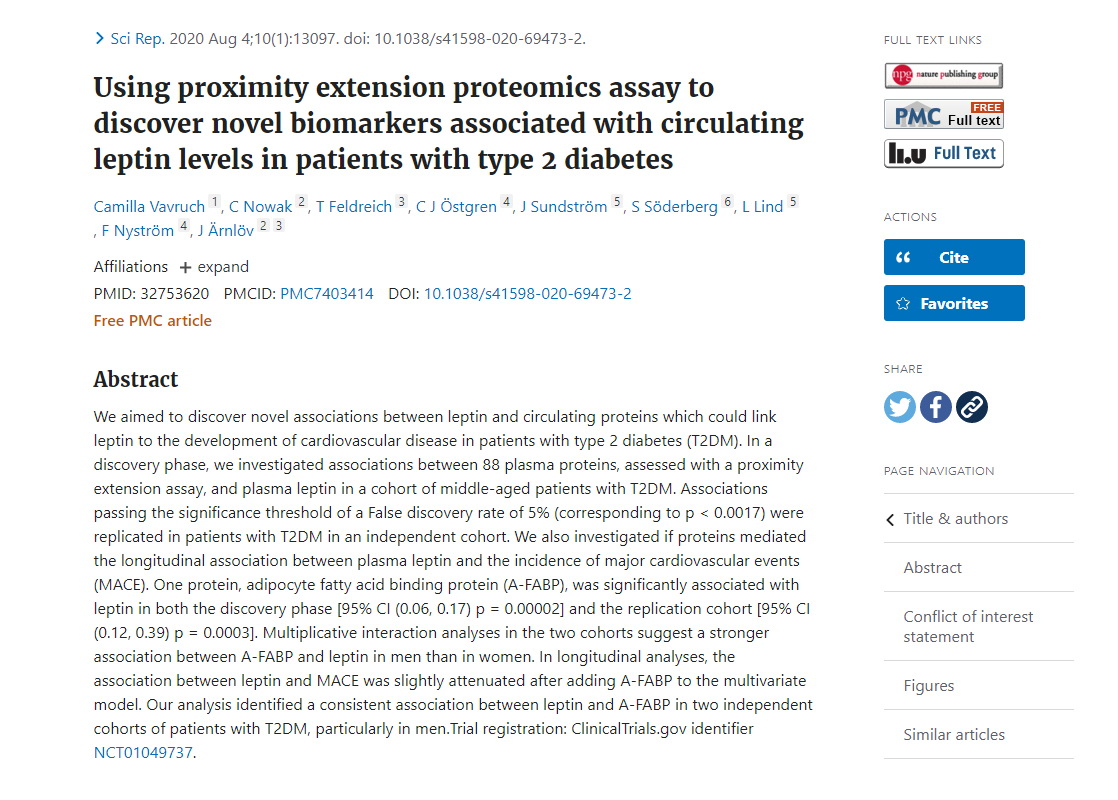Under december 2019 hade jag forskningstid och en del av den tillbringade jag i Falun hos en annan forskargrupp än den jag brukar ingå i. Det har nu resulterat i en artikel som handlar om leptin (som är huvudämnet för min avhandling), men denna gång har vi använt proteomik-teknik.
Proteomiken ger möjlighet att titta på väldigt många proteiner i ett prov (blod i vårt fall, och 88 proteiner för vår del; numera finns det proteomik som kan ta flera tusen olika proteiner i ett enda test) och svarar ut som proteinnivåerna inte som absoluta nivåer utan i relation till varandra. Vi valde leptin som det protein vi mätte mot och hittade en association med A-FABP (adipocyte fatty acid binding protein) i våra två kohorter med patienter med typ 2 diabetes, mer uttalat i män än kvinnor.
Enlarge

Jag gissar att intresset för detta är gaaaanska lågt bland personer som läser bloggen, men jag är mycket stolt över att ha författat den här artikeln från början till slut, givetvis med stor hjälp från framför allt min huvudhandledare för artikeln Johan Ärnlöv. Därför får den ligga här ändå.
Hela artikeln finns att läsa här, Natures open access (den är inte publicerad av Nature givetvis, den är i Scientific Reports, men Nature har många tidningar under sig).





Grattis till publikationen! Som kemi- och biologilärare har jag lite koll (dessutom med en master i kemi med inriktning mot biokemi). Men lite över gymnasieelevernas nivå. Dock har jag tränat med dem att läsa vetenskapliga artiklar på engelska – men då läser vi sällan hela utan vi tränar mer på att sammanfatta och plocka ut det viktiga.
Tack! Coolt att du tränar dem att läsa vetenskapliga artiklar, så blir det inte någon chock på universitetet. När jag gick några psykologikurser för många år sedan trodde några av de andra studenterna att med ”hänvisa till relevanta artiklar” ingick att hänvisa till artiklar på Aftonbladet, så…
/Cosmonomics
Gissar att typ 2 diabetes är vanligare än man tror. Det finns antagligen några även bland bloggens läsare.
Dock inte jag, även om det är nära…
Hur ser du på utbredningen?
Besser
Ungefär en halv miljon i Sverige uppskattades år 2017 ha diabetes typ 2 i Sverige. Så det är vanligt, ja. Och blir allt vanligare.
/Cosmonomics.se
Intressant, vad kan ni göra av resultatet?
Inte så mycket i nuläget. Det är en väldigt liten pusselbit i forskningen om vikt och diabetes.